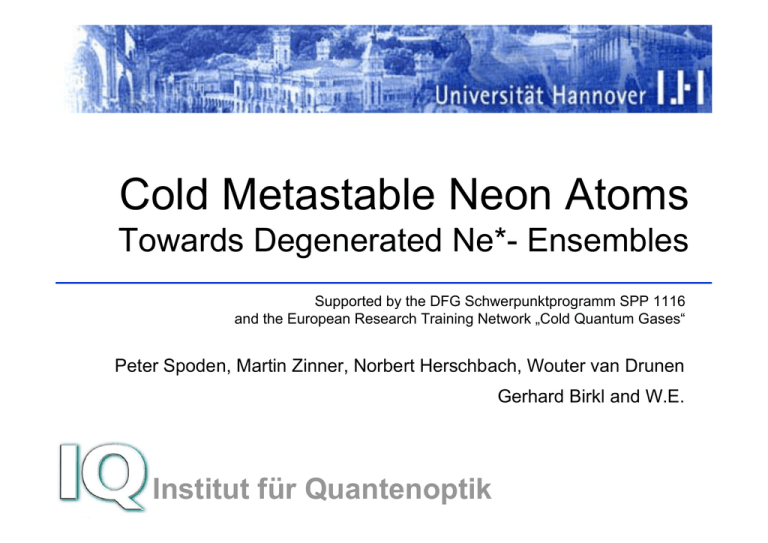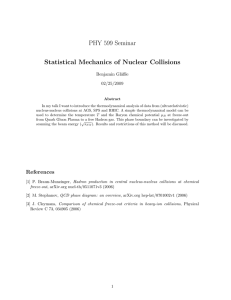Cold Metastable Neon Atoms
advertisement

Cold Metastable Neon Atoms Towards Degenerated Ne*- Ensembles Supported by the DFG Schwerpunktprogramm SPP 1116 and the European Research Training Network „Cold Quantum Gases“ Peter Spoden, Martin Zinner, Norbert Herschbach, Wouter van Drunen Gerhard Birkl and W.E. Institut für Quantenoptik Outline 3D 3 • Metastable neon 3P 2 • 3P2-Lifetime 2p6 τ2 • Elastic collisions and scattering length • Evaporative cooling Population • Inelastic collisions and their suppression RF-knife (η=E/kT) • Outlook E n e rg y Neon Naturally occurring Neon-Isotopes Mass 3D 3p[5/2]3 Abundance [%] Nuclear Spin 20 90.48 0 21 0.27 3/2 22 9.25 0 3 1P 1 3s’[1/2]1 3P 0 3s’[1/2]0 E1 640 nm 3P 1 3P 2 3s[3/2]1 3s[3/2]2 τ2 = ? M2 16.6 eV 1S 0 2p6 J =0 J =1 J =2 J =3 • Laser-cooling parameters: Wavelength 640 nm Doppler limit 200 µK Recoil limit 2.3 µK Penning-Ionization: Ne*+Ne* Ne+ + Ne + e- From atomic physics to BEC Atomic physics • Lifetime of the metastable state: ? 640 nm 16,6 eV M. Zinner et al., PRA 67, 010501(R) (2003) Collision physics • Rates of elastic and inelastic collisions • Suppression of Penning-Ionization by spinpolarization: 104 ? Electronic Detection • Direct, highly efficient detection of Ne* and Ne+ • Real-time detection of ions • Spatially resolved detection of atoms Bose-Einstein-Condensation • Investigation of collective excitations • Measurement of higher order correlation functions thermal BEC From atomic physics to BEC Atomic physics • Lifetime of the metastable state: ? 640 nm 16,6 eV M. Zinner et al., PRA 67, 010501(R) (2003) Collision physics • Rates of elastic and inelastic collisions • Suppression of Penning-Ionization by spinpolarization: 104 ? Electronic Detection • Direct, highly efficient detection of Ne* and Ne+ • Real-time detection of ions • Spatially resolved detection of atoms Bose-Einstein-Condensation • Investigation of collective excitations • Measurement of higher order correlation functions thermal BEC Experimental Setup Lifetime of the metastable state 3D After Loading the MOT 3 3p[5/2]3 1P 1 3s’[1/2]1 3P 0 3s’[1/2]0 E1 640 nm 3P 1 3P 2 3s[3/2]1 τ2 1S 0 3s[3/2]2 M2 16.6 eV 2p6 J =0 J =1 J =2 J =3 observation of decay by fluorescence Fluorescence of 20Ne in a MOT 3D 3 • MOT decay excitation 47% α-1 = 21.7 s 2 N N& = − α N − β Veff π2 π3 α= + ττ2 τ 3 2 radiative decay +γ⋅p background collisions 1000000 τ2 Fluorescence [au] • Origins of one-body losses 3P 2 2p6 100000 10000 1000 + α FT excitation 0.5% α-1 = 14.4 s finite trap depth • population of 3P2-state: π2 • population of 3D3-state: π3 100 0 20 40 60 80 time of MOT decay [s] 100 120 π3 π2 Background gas collisions: γ⋅p • Pressure dependency of MOT decay background gas collisions 7 -1 -1 γ = 5.2(1)*10 mbar s 0,14 • Offset of pressure gauge: 4(7) 10-12 mbar • Ionization processes: Ne* + X = Ne + X+ + e- 0,12 • Ion signal on MCP: = c1(p) N(t) + c2 N²(t) 0,10 1,0 0,9 0,8 0,08 background gas collision rate -11 1/640s @ p=3 10 mbar c1 [arb. units] -1 α [s ] Rion(t) 0,7 0,6 0,5 0,4 0,3 0,2 0,1 0,06 0 25 50 75 100 125 0,0 0 -11 pdisplay [10 mbar] 1 2 3 4 5 6 7 8 9 pdisplay [10-11mbar] 10 11 12 Influence of finite trap depth 0,35 • For an infinitely large MOT: π3 = 0.016 0,30 escape velocity become infinite • therefore: let the gradient B‘ approach zero! α [s-1] trap depth and 0,08 0,07 0,06 0,05 0 20 40 60 Gradient [G/cm] 80 • In practice: Trap depth remains finite due to finite size of laser beams • No significant dependency of α on B’ • No correction needed for low excitation measurements 100 τ2 of the metastable 3P2-state 0,07 14.3 0,06 16.7 0,05 20.0 0,04 0,0 αp=0-1 [s] αp=0 [s-1] Lifetime 25.0 0,1 0,2 0,3 0,4 0,5 Population in 3D3-state (π3) Error budget: thus: measured α p=0 extrapolation π=0 extrapolation α(p=0, π=0) τ2 0.06918(51) s-1 - 0.00156(37) s-1 + 0.00028(13) s-1 0.06790(64) s-1 14.73(14) s From atomic physics to BEC Atomic physics • Lifetime of the metastable state: 14.73(14)s 640 nm 16,6 eV M. Zinner et al., PRA 67, 010501(R) (2003) Collision physics • Rates of elastic and inelastic collisions • Suppression of Penning-Ionization by spinpolarization: 104 ? Electronic Detection • Direct, highly efficient detection of Ne* and Ne+ • Real-time detection of ions • Spatially resolved detection of atoms Bose-Einstein-Condensation • Investigation of collective excitations • Measurement of higher order correlation functions thermal BEC Preparation of spin-polarized atoms Preparation of Magnetically Trapped Atoms Sequence Beam collimation and slowing MOT loading 400 ms Compressed spin MOT polarization σr=1.3mm N=6x108 78% in mJ=+2 +2 +1 0 -1 -2 0 µs 2 µs 4 µs Doppler Cooling PSD = 4.5x10-7 axial: ~200 µK radial: ~450 µK Transfer to MT and adiabatic compression B0= 25 G N = 3x108 8 µs Stern-Gerlach Experiment Doppler-cooling in the magnetic trap • σ+-σ+- irradiation in axial direction of magnetic trap Taxial 2000 Tradial T [µK] 1500 1000 500 Axial: Doppler cooling Radial: cooling by reabsorption • Optimized parameters: ∆ = -0.5 Γ I = 5x10-3 Isat • 50-fold gain in phase space density TDoppler = 196 µK 0 0 500 1000 t [ms] 1500 2000 Elastic collisions Cross-dimensional Relaxation 22 Ne • Kinetic energy is not in equilibrium after Doppler-cooling T [µK] 700 • Aspect ratio of the cloud changes 600 T axial 500 T radial σ ax A= σ rad T 400 0 1 2 3 4 5 t* [s] 1,4 A 1,2 • Determination of the relaxation rate A& = γ rel ( A(t) − Aeq ) 1,0 Mean density: 9 -3 2.9 10 cm 9 -3 6.4 10 cm 10 -3 1.3 10 cm 0,8 0 1 2 3 t* [s] 4 5 Cross-dimensional Relaxation 2.5 22Ne • Description of the relaxation rate γrel = σ rel n v γrel [s-1] 2.0 1.5 • Connection to elastic collisions 1.0 0.5 0.0 0.0 σ rel = 5.0x1015 1.0x1016 1.5x1016 2.0x1016 2.5x1016 n v [m-2 s-1] • Relaxation rate is proportional to density: Kinetic energy is redistributed by elastic collisions! σ el ⋅ v 5rel 4.24 v 4rel T T v G. M. Kavoulakis, C. J. Pethick, and H. Smith Phys. Rev. A 61, 053603 (2000) Cross Section of elastic collisions 10 V [meV] 5 0 -5 u( r ) ∝ sin(kr + δ 0 ( k )) -10 -15 -20 0 100 200 300 400 500 600 700 800 900 1000 r [a0] • Centrifugal barrier for d-waves: 5,8 mK Regime of s-wave-scattering • Interaction potential: Short range: Long range: • Cross section: S. Kotochigova et al., PRA 61, 042712 (2000) A. Derevianko und A. Dalgarno, PRA 62, 062501(2000) 8π σ el ( k ) = 2 sin 2 (δ 0 (k )) k Effective-range approximation: 2 σ ER = 8π a k a + ( k re a − 1) 2 2 1 2 2 2 Relaxation cross section -16 2,0x10 Unitarity limit 22 Ne: a= 100 a0 a=-6500 a0 20 Ne: , a= +20 a0 -16 1,5x10 2 σrel [m ] a= -130 a0 -16 1,0x10 -17 5,0x10 0,0 200 400 600 800 1000 T [µK] Effective range approximation Numerical calculation (shown) 20Ne: -105(18) a0 -120(10) a0 or +20(10) a0 22Ne: +150 a0 < a < +1050 a0 (or +14.4 a0) +70 a0 < a < +300 a0 (100 a0) Inelastic collisions Simple model of Penning-Ionization 0.0015 • Ionization with unit probability below a minimal distance σ ion ,l = k 2 (2l + 1) PT ( k , l ) 0.0005 0.0000 Ionization π 0.0010 V [meV] • Model (Xe*, NIST) l=0 l=1 l=2 l=3 PT(l=3) -0.0005 -0.0010 50 PT.. transmission probability 100 150 200 r [a0] -9 10 -10 10 3 β ~ 2-3 10-10 cm3s-1 β [cm /s] • Result: -11 10 l=0: s-waves l=1: p-waves l=2: d-waves l=3: f-waves β unpol 0,1 1 T [mK] 10 Unpolarized atoms • Measurement in MOT 2 N N& = − α N − β Veff • Consideration of excited atoms S+S collisions: Kss S+P collisions: Ksp Fluorescence [arb. units] 7 10 6 10 5 10 4 10 0 5 t [s] 10 15 for small excitation πp: β = Kss + 2 (KSP-KSS) πp -9 1,0x10 -10 cm /s -8 3 Kss= 2.5(8) 10 3 Ksp= 1.0(4) 10 cm /s 20Ne 22Ne Kss [cm³ s-1] 2.5(8) 10-10 8(5) 10-11 Ksp [cm³ s-1] 1.0(4) 10-8 5.9(25) 10-9 β [cm³/s] -10 7,5x10 -10 5,0x10 -10 2,5x10 0,0 0,000 0,005 0,010 0,015 πp 0,020 0,025 Suppression of Penning-Ionization Exchange process • Dominant loss process in MOT τ < 1s @ n=109 cm-3 (MOT) - 3s + • Suppression for spin polarized ensembles Limitation of suppression by anisotropic contributions to the interaction during collisions He*: 105 ⇒ BEC Xe*: 1 ⇒ BEC Ne* ? - core 2p5 Ne* + Ne* S=1 3s ⇒ S=1 ⇒ S tot = 2 Ne + core 2p5 + Ne+ S=0 S=1/2 + eS=1/2 S tot ≤ 1 Spin polarized atoms 750 108 N Tmean [µK] 700 107 650 600 550 106 0 10 t [s] 20 0 30 2 4 t' [s] 2 N N& = − α N − β Veff Heating! 6 Trap loss t Analysis: 2 N N& = − α N − β Veff N(t)-N( 0 ) = −α − β t ∫ N(t')dt' N 2(t') ∫0 Veff (t') dt' t ∫ N(t')dt' 0 0 20Ne -0,1 -1 Suppression: 50(20) N ( t ) − N ( 0) t 22Ne β = 9.4(24) 10-12 cm3 s-1 Suppression: 9(6) 20Ne (N(t)-N0) / N(t)dt [s ] β = 5.3(15) 10-12 cm3 s-1 ∫ N (t ' )dt ' 0 [s ] -0,2 −1 -0,3 10 1x10 10 2x10 N 2 (t' ) dt ' -3 0 V / ( n(t)N(t)dt N(t)dt [cm ] eff t ' ) −3 [ ] cm t N ( t ' )dt ' ∫ t ∫ 0 Heating • Inherent heating due to 2-body-losses 750 22 Ne: β = 10,2(27) 10 N& inelast ( r , t ) ∝ − β n 2 ( r , t ) T& 1 = βn T 4 3 cm s -1 700 Tmean [µK] • other mechanisms • collisions with background gas • secondary collisions -12 650 600 20Ne: βheat = βloss = 5.6(15) 5.3(15) 22Ne: βheat = βloss = 10.2(27) 10-12 cm3s-1 9.4 (24) 10-12 cm3 s-1 10-12 cm3s-1 10-12 cm3 s-1 550 0 1 2 3 4 t' [s] 5 6 7 Population Evaporative cooling Inelastic collisions RF-knife (η=E/kT) Elastic collisions Energy Conditions for evaporative cooling • „Good-to-bad“ ratio R= Efficiency parameter γ el γ loss χ =− 20Ne: R~5-15 22Ne: R~30-50 1,0 R=10 R=30 R=50 0,5 22Ne is better suited for evaporative cooling than 20Ne ! χ • d (ln ρ Φ ) d (ln N) 0,0 -0,5 -1,0 4 6 8 η Cut-off parameter η=ETrap/kBT 10 Experimental realization 1500 Tax • Ramp: from 80 MHz to 44 MHz Trad Trap depth: from 5.5 mK to 1.2 mK Initial cut-off parameter: η=4,5 T [µK] 1250 T 1000 • variable duration of RF-irradiation 750 • Observation: 500 0 1000 1500 2000 tRampe [ms] 1.50x1010 n0 1.25x1010 n0 [cm-3] T Phase space density ? 500 1.00x1010 7.50x109 5.00x109 0 500 1000 tRampe [ms] 1500 2000 Increase in phase space density Evaporation protocol RF [MHz] 80 Ramp #1 44 Ramp #2 34 Ramp #3 29 • Initial conditions ETrap [mK] 5.5 1.2 1.0 0.6 η 4.5 2.7 3.9 4.5 N n0 T ρ = = = = 5 x 107 1,3 x 1010 cm-3 1.2 mK 1.6 x 10-8 • Final conditions -6 Phase space density 10 N n0 T ρ Start Ramp #1 Ramp #2 Ramp #3 = = = = 5 x 105 5 x 109 cm-3 130 µK 1.9 x 10-7 -7 10 • Efficiency of evaporative cooling χ ≈ 0.6 -8 10 5 10 6 7 10 10 N 8 10 Prospects for BEC • Ne* as compared to Bose-condensed species: very high loss rates high rates of elastic collisions • Numerical simulation of optimized evaporative cooling 1 -1 10 phase space density phase space density 1 -2 10 -3 10 -4 10 -5 -11 10 β = 10 3 -1 cm s -12 3 -1 β = 10 cm s -13 3 -1 β = 10 cm s -6 10 -7 a = 100 a0 a = 310 a0 a = 1000 a0 -1 10 -2 10 -3 10 -4 10 -5 10 -6 10 -7 10 4 10 5 10 6 10 N 7 10 8 10 10 2 10 3 10 4 10 5 10 N 6 10 7 10 8 10 Results Summary • Penning ionization (unpolarized, 20Ne) Kss = 2.5(8) 10-10 cm³ s-1 Ksp = 1.0(4) 10-8 cm³ s -1 • Elastic collisions 20Ne: 22Ne: a = +20(10) a0 or -110(20) a0 +70 a0 < a < +1050 a0 • Penning ionization (unpolarized, 22Ne) Kss = 8(5) 10-11 cm³ s-1 Ksp = 5.9(25) 10-9 cm³ s -1 • Evaporative cooling Phase space density x 10 Efficiency χ~0,6 • Two-body losses (spin-polarized) 20Ne: β = 5.3(15) 10-12 cm3 s-1 22Ne: β = 9.4(24) 10-12 cm3 s-1 • Lifetime of the 3P2-state (20Ne): 14.73(14) s M. Zinner et al., PRA 67, 010501(R) (2003) • Suppression of Penning ionization 20Ne: ~ 50 22Ne: ~9 Outlook • Continue experiments on evaporative cooling of 22Ne to highest possible phase space density • Ion rate measurements with the MCP • Investigation of collision properties, especially influence of external (magnetic) fields • Manipulation of Interactions? • Transfer into an optical dipole trap • Photo-association spectroscopy Collisions in cold gases Elastic Collisions Interaction potential • Scattering length a: σ el ,T →0 = 8π 0.0015 0.0010 V [meV] 0.0005 a2 • „motor“ of evaporative cooling • Stability of a BEC • Scattering resonances 0.0000 -2 -4 -6 -8 -10 Inelastic Collisions l=0 l=1 l=2 l=3 -12 -14 -16 -18 • Loss parameter β: -20 5 10 15 20 50 100 150 200 N& inel = − 2 σ inel v rel N r [a0] • Potential depth: ~20 meV • Long-range potential: C 6 h 2 l (l + 1) VLR (r ) = − 6 + r 2m r 2 σ inel ,T →0 ∝ • • • • T 1 k n =− βn „brake“ of evaporative cooling Heating Penning-Ionization Influence of spin-polarization Numerical calculation of scattering phases 0,5 π -340 a0 • Interaction potential -144 a0 0,0 π + 59 a0 +151 a0 -0,5 π δ0 • S. Kotochigova et al., PRA 61, 042712 (2000) • A. Derevianko und A. Dalgarno, PRA 62, 062501(2000) - 58 a0 • Numerical determination of the s-wave radial wavefunction gives δ0 +301 a0 -1,0 π -1,5 π -2,0 π 0,00 ul ( r ) ∝ sin(kr + δ 0 ( k )) 0,02 0,04 0,06 0,08 0,10 -1 k [a0 ] 0.5 π • Cross section 8π 2 (δ 0 (k )) sin 2 k δ0 σ el ( k ) = 0.0 π -0.5 π a= -342,1 a0 a= -104,3 a0 a= - 58,0 a0 a= + 44,3 a0 -1.0 π a= +101,1 a0 a= +301,1 a0 10-4 10-3 10-2 k [a0-1] 10-1 Relaxation cross sections 10-15 σ [m²] 10-16 10-17 a= -100 a0: 10-18 σel σrel a= +100 a0: σel 10-19 σrel 10-20 10 100 1000 T [µK] 10000 Inelastic collisions of metastable neon MOT MT discharge (310K) Sheverev et al. J. Appl. Ph. 92, 3454 (2002) Suppression 20Ne: 50(20) 22Ne: 9(6) Decay rate vs. Gradient II 5 4 3 Parameters: ∆= -0.17Γ, s=5 π 3 = 0.41 -1 α [s ] 0,07 0,06 0,05 0,04 0,03 0 < LM < 0.005 0,02 0 5 10 15 20 25 30 35 G rad ien t [G /cm ] Problems: • Theories hold for small saturation • Models discussed fail to explain the data quantitatively • Ionizing background collisions


